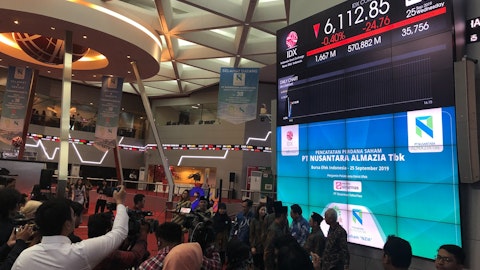Trinity Capital Inc. (NASDAQ:TRIN) Q4 2022 Earnings Call Transcript March 2, 2023
Operator: Good afternoon. My name is Chelsea, and I will be your conference operator today. At this time, I would like to welcome everyone to the Trinity Capital’s Fourth Quarter and Full Year 2022 Earnings Conference Call. Our hosts for today’s call are Steve Brown, Chairman and Chief Executive Officer; Kyle Brown, President and Chief Investment Officer; David Lund, Chief Financial Officer; Michael Testa, Chief Accounting Officer; and Sarah Stanton, General Counsel. Gerry Harder, Chief Operating Officer; and Ron Kundich, Chief Credit Officer are also present. Today’s call is being recorded and will be made available for replay at 8:00 PM Eastern Time. The replay dial-in number is 1800-934-3336 and no conference ID is required for access. . It is now my pleasure to turn the call over to Sarah Stanton. Please go ahead.
Sarah Stanton: Thank you, Chelsea, and welcome, everyone, to Trinity Capital’s earnings conference call for the fourth quarter and full year 2022. Trinity’s fourth quarter and full year 2022 financial results were released just after today’s market close and can be accessed from Trinity’s Investor Relations website at ir.trinitycap.com. A replay of the call is available on Trinity’s website or by using the telephone number provided in today’s earnings release. Before we begin, I would like to remind everyone that certain statements that are not based on historical facts made during this call, including any statements relating to financial guidance, may be deemed forward-looking statements under Federal securities laws. Because these forward-looking statements involve known and unknown risks and uncertainties, there are important factors that could cause actual results to differ materially from those expressed or implied by these forward-looking statements.
We encourage you to refer to our most recent SEC filings for information on some of these risk factors. Trinity Capital assumes no obligation or responsibility to update any forward-looking statements. Please note that the information reported on this call speaks only as of today, March 2, 2023. Therefore, you are advised that time-sensitive information may no longer be accurate at the time of any replay listening or transcript reading. Now, please allow me to introduce Trinity Capital’s Chairman and CEO, Steve Brown.
Steve Brown: Thank you, Sarah. Thank you to everyone joining us today. As you saw in our earnings release this afternoon, we generated strong fourth quarter results to finish an incredible year, exceeding expectations and breaking records on many financial metrics. Our talented team delivered an exceptional performance in 2022 for our shareholders, and I’d like to start by recapping just a few of our many achievements. First, our originations and fundings brought us to $1.1 billion in total assets, growing our total asset position by 20% as compared to the end of 2021. Second, our investment portfolio at costs grew by 45% which generated a $145.5 million in total investment income. Third, our net investment income came in at $21.6 million for the fourth quarter and $71.6 million for the year, representing increases of 104% and 83% over the prior year periods.
This outstanding performance allowed us to deliver NII of $0.62, and $2.26 per share for the quarter and the year. We just delivered our eighth straight quarter of dividend increases. For 2022, we declared combined regular and supplemental dividends totaling $2.33 per share for our shareholders, an 85% increase over the 2021 dividends. Our NII per share of $0.62 for Q4 represents a $0.06 increase from the prior quarter and 135% coverage on our core dividend. Our return on average equity based on NII increased to 17.9%. Fourth, in the first quarter, we realized gains from the sale of our investment positions in Lucid and Matterport that contributed to the $33 million or $0.94 per share of realized gains on the ending share basis. Lastly, we ended 2022 with approximately $60 million, or $1.73 of undistributed income.
As a reminder, the undistributed income from 2021 of approximately 19 million was distributed through the $0.60 supplemental dividends we declared and paid in 2022. Shifting to our capitalization and liquidity, we remain very active during the year despite a challenging market. We raised additional accretive capital, upsized our credit facility and reopened our 7% notes in order to maintain strong liquidity for our growing investment portfolio. The successful completion of two publicly underwritten offerings in 2022 and the use of our ATM program supported the continued long-term growth of Trinity. All of these capital raising activities allowed us to deliver a record year for both commitments and deployments. We originated 976 million in new commitments and funded 631 million across 66 portfolio companies.
Throughout the course of 2022, we continue to invest in the company’s platform, infrastructure and people. To that end, we added talent to all levels of our organization and have grown the team by almost 40% this year to 57 employees. We also expanded our platform with the addition of an experienced life science team, adding originations in this important market vertical. Our results in Q4 and 2022 demonstrate the strength of our team, our ability to meaningfully grow our portfolio, generate significant yields, manage credits, even in a volatile market. I will now hand it over to Kyle Brown, our President and Chief Investment Officer to provide updates on our portfolio composition and investment performance. Kyle?
Kyle Brown: Great thanks, Steve, we are truly pleased with the performance of our originations and credit team during 2022. I mean we originated $976 million in commitments and $631 million in investments. Our portfolio grew to $1.1 billion on fair value basis, an increase of 25% on a fair value basis. Investment activity led to the addition of 34 new portfolio companies during 2022. During the fourth quarter, we entered into commitments of $239.5 million and funded $121.4 million, including $71 million in deployments to seven new portfolio companies and $15.4 million in gross deployments to non-existing portfolio companies. We finished the quarter with $393 million of unfunded commitments, which provides us with a strong pipeline for continued fundings leading into 2023.
And as a reminder, our unfunded commitments are subject to ongoing diligence and approval by our Investment Committee. Our pipeline activity remains solid for Q1, despite narrowing our funnel and tightening our investment criteria. To meet this growing opportunity, we completed two transformative initiatives in 2022 with the close of our joint venture, and SEC exemptive relief for our RIA. We are encouraged by the multiple growth levers we have in place, which are differentiating ourselves in the BDC industry. Our JV structure not only allowed us to expand the portfolio, but also generate predictable fee income, while keeping the balance sheet healthy and nimble. The RIA structure will allow us to raise funds off the balance sheet providing outsized returns for investors in a complementary way.
We can now raise co investment type vehicles to grow the platform with the ability to raise capital from multiple channels all to the benefit of the BDC, which owns 100% of this RIA. At Trinity, we believe our internal management structure enhances our shareholder alignment and ability to think outside the box. Its off balance sheet growth is one example of that. As we enter 2023, we are proceeding with caution as we review our investment opportunities. The number of growth stage companies looking for structured debt has increased while pressure persists on the revaluation of these companies. We believe this is a time for opportunity, but it must be navigated with sound judgment. Continuous diligent monitoring of our portfolio companies is an essential component to our successful credit management.
We maintain a dedicated portfolio management staff whose sole function is to monitor our credit risk, keep a watchful eye on the market impact and stay in constant communication with management teams and their equity stakeholders. Our focus is on building a trusted partnership supported by ongoing two-way communication. This combination is proven to be successful, as demonstrated by our solid investment track record and reputation partnering with our portfolio companies. To that end, during 2022, we added to our credit team to ensure that we remain attentive to the performance of portfolio companies. The composition of our portfolio remains relatively consistent with prior quarters and represents diversification across 19 industries. This quarter we revised our industry breakdown to further underscore the granularity and diversification of our portfolio.

Photo by Vadim Bozhko on Unsplash
Our debt investments are primarily split between venture debt and equipment financings at fair value 73% of our debt portfolio, or $802.9 million is comprised of secured loans, while 23% or $246 million is invested in equipment financings. The remainder of our portfolio $45.5 million at fair value is comprised of equity and warrants. Our credit quality and portfolio remain stable with 95% of our debt investments at cost performing. I’d like to address one investment industry in particular, that has been an area of concern for investors, that being digital asset technologies. We continue to reduce our exposure to these investments. These are fully amortizing payments on 36 months schedules, which is resulting in a decrease in balance of 3% per month.
Two of our three investments in the space are in the performing category as of year-end, our investment with Core Scientific remains in default that the loan is collateralized by critical computing equipment with a cost basis of $23 million, and fair value of $8.2 million, which is approximately 36% of cost. The fair value of the note at year end was based on the estimated value Tera hash pricing for the underlying equipment which fluctuates the value of Bitcoin. We believe the recent recovery of Bitcoin prices up 40% since this March should benefit Core’s operating performance and liquidity position. We remain in close communication with the company and are exploring all available options to obtain the best possible outcomes to the benefit of our shareholders.
Subsequent to the end of the fourth quarter, another of our publicly traded digital asset portfolio companies Hut 8 Mining announced a merger with U.S. Bitcoin Corp. According to the companies, that transaction is expected to close in the second quarter of 2023. That would trigger a pay-off event and further reduce our investments in digital asset technologies. We continue to monitor the progress of the closing and expect to have more to share over the next couple of quarters. In Q4 the number of loans on non-accrual remains the same with four debt investments with the cumulative investment cost and fair value of approximately $49.2 million and $17.8 million respectively or 4.3% and 1.6% as a percentage of the company’s total investment portfolio at cost and value respectively.
Lastly, as of December 31, 2022, NAV per share decreased to $13.15 compared to $13.74. The decrease in NAV per share was primarily the result of net investment income that exceeded the company’s declared dividend by $0.01 per share offset by the unrealized depreciation and realized losses recognized during the fourth quarter, approximately 75% of the unrealized depreciation was related to two portfolio companies, FemTec Health and Core Scientific, previously identified as troubled credits in prior quarters. Let me pass the call to Dave to discuss our operating performance in more detail. Dave/
David Lund: Thank you, Kyle. As Steve and Kyle mentioned this was an outstanding quarter and year for Trinity across multiple performance fronts. Turning specifically to our fourth quarter financial performance, our portfolio growth of 45% during 2022 and the increase in benchmark rates contributed to our total investment income of $41.5 million, a 75.8% increase over the same period in 2021 and a 7.3% increase over the third quarter of 2022. Fee income decreased to $909,000 as our early loan repayments to only $14.8 million in the quarter. Our effective yield on the portfolio for Q4 was 15.5%, an increase from 15.2% in the third quarter. Our core yield which excludes nonrecurring fee income increased to 14.2% from 13.5% from the prior quarter.
Both our effective yield and core yield primarily increased due to the rise in benchmark rates. Year-over-year total investment income increased by 77% to a record $145.5 million in 2022, from $82.2 million in 2021. Our consistent originations helped drive this increase while we maintain a consistently high effective yield across the portfolio. Our debt portfolio continues to be well positioned ahead of anticipated future rate hikes with 68% of our debt investments at floating rates, while on the borrowing side only 30% of our outstanding debt at the end of the fourth quarter what is a variable rate at SOFR. We incurred a total of $10.3 million in interest expense and amortization and deferred financing costs on various debt facilities as compared to $9.3 million in Q3.
The increase in interest expense was primarily due to the full quarter of expense incurred under the $57.5 million of additional 7% notes issued in Q3, and an increase in the interest rate and weighted average borrowings outstanding during the quarter under our KeyBanc credit facility. Our other operating expenses were approximately $9.6 million during Q4 as compared to approximately $10.8 million during Q3. The decrease of approximately 11% was primarily driven by a decrease in variable compensation expense, and lower excise tax expense. As a result of this operating activity, net investment income for the fourth quarter was $21.6 million, or $0.62 per basic share an increase of 16%, compared to $18.6 million, or $0.56 per basic share in Q3.
For the full year of 2022, net investment income increased to $71.5 million, as compared with $39 million in 2021 an increase of 83% year-over-year. We recorded net unrealized depreciation of $13.6 million during the quarter. We recognized unrealized depreciation of $23.2 million in our debt portfolio, and $885,000 in our equity and warrant portfolio, offset by the flip of $10.5 million to realize losses on portfolio investments previously depreciated on an unrealized basis. Approximately $18.2 million of the unrealized depreciation in the debt portfolio was related to the performance issues with the two portfolio companies that Kyle previously reviewed. The remainder of the unrealized depreciation was primarily attributed to mark-to-market adjustments due to general market volatility and interest rate changes.
Our operating activities generated strong returns for our shareholders with our ROAE based on NII over average equity of 17.9% and ROAA based on NII over average total assets of 7.7%. I will now hand the call over to Mike Testa, our Chief Accounting Officer who will discuss our credit performance, liquidity and capital allocation. Mike?
Michael Testa: Thanks, Dave. Turning to credit quality, our portfolio companies continued to perform well in fourth quarter of 2022 with approximately 95% of our portfolio performing at cost. As Kyle mentioned, at the end of the quarter, we had four investments on nonaccrual, representing just 1.7% of the fair value of the investment portfolio. Our average credit rating for the fourth quarter stood at 2.8 based on our 1 to 5 rating system with 5 indicating very strong performance. This rating is just slightly lower than our average credit rating of 2.9 in Q3. Our overall credit quality has remained solid. We’ve taken practical approach to all those in our portfolio. We continue to diligently monitor our portfolio companies’ performance, being mindful of the macro environment that could impact our operations.
Moving to liquidity as of December 31, 2022, we had total liquidity of approximately $173 million comprised of approximately $162 million of undrawn capacity under our credit facility, and $11 million in unrestricted cash and cash equivalents. Our net leverage ratio, which represents debt outstanding less cash on hand, increased to 1.33x this quarter, as a result of our borrowings on our credit facility, which contribute to our portfolio growth. As of December 31st, total debt principal outstanding was $620 million and had a weighted average cost of debt of 6.8%, up from 6.3% at September 30th, due to higher base rates on our credit facility. Unsecured debt represented 70% of the total debt at quarter end, down slightly from the prior quarter as we borrowed under our credit facility.
With the majority of our investment portfolio imploding reinvestments compared to the majority of our outstanding borrowings at fixed rates, we expect that further increases in the base rates in 2023 would positively impact our net interest margin and NII margin. Our leverage position, liquidity strength and access to the capital continue to be at the forefront of our strategy. We continue to explore all capital options that will be accretive to our shareholders. This includes funding investments under our recent announced JV and RIA that we are looking to launch in 2023, which will allow for complimentary off balance sheet growth and additional fee income for Trinity. In Q4, we announced our stock repurchase program that will allow us to repurchase up to $25 million of our common stock.
We believe that stock buybacks are an accretive use of shareholder capital when the stock is trading at a meaningful discount to NAV. To that end, we repurchased approximately 186,000 shares at an average price of $10.77 per share, so for an aggregate repurchase price of $2 million. The program demonstrates our commitment to creating value for our shareholders, as the repurchase had accretive impact of $0.02 per share on NAV. In conclusion, on December 15, 2022, our Board declared a cash dividend of $0.46 per share for the fourth quarter of 2022, representing a 2% increase from Q3 2022. This is the eighth quarter in a row that we have increased our core business. Our GAAP NII generated coverage of approximately 135% of our regular dividend for the quarter.
Additionally, the Board approved a $0.15 per share supplemental dividend. Both dividends were paid on January 13, 2023. Our Board of Directors generally makes a determination of our dividend distributions on a quarterly basis. And we anticipate making an announcement of our Q1 2023 dividend in the second half of March. With that, I’ll now open the line up for questions. Operator?
See also Billionaire Ken Fisher’s New Purchases and 25 Most Profitable Companies in the World.
Q&A Session
Follow Trinity Capital Corp
Follow Trinity Capital Corp
Operator: And our first question will come from Finian O’Shea with Wells Fargo.
Finian O’Shea: Our first question, are you able to provide us any color on the portfolio company level liquidity, cash runway and so forth? And maybe a higher level fundraising backdrop?
Ron Kundich: Yes, this is Ron. In terms of portfolio cash runway, we’re obviously actively monitoring our portfolio on a monthly, if not on often basis. We track those numbers on a company by company basis. We do not have a aggregate — we don’t keep track of the aggregate. But we take each of those into account as we grade and value the portfolio regularly.
Steve Brown: For all new investments then we do track and I’d say the one maybe adjusted to underwriting that we’re considering is we really want to see 18 to 24 months or more of runway for any new investment coming to portfolio is something that we continue to focus on.
Finian O’Shea: And then just to follow-up on the RIA. Any sort of type of vehicle in mind and is this something that you would potentially or likely commit Trinity equity to get vehicle started?
Steve Brown: That’s a good question. I think part of the part of the purpose of the RIA is to manage other people’s money. And so, the goal will be to generate new fee income and carried interest in a fund structure, utilizing someone else’s capital primarily. And we are in process, currently, we have begun those discussions with investors and potential investors. And we believe that funds managed by the RIA have the potential to generate a significant amount of income to the BDC in the future. And the structure of it would also be, I think, primarily, at least initially a co-investment vehicle, which will be complementary and help us continue to make new investments, generate new income, and not — and give us the again, just like the JV the ability to be nimble to BDC level, maximize our capital there.
And then for investments that don’t fit the BDC whether it’s bad income or there’s a variety of reasons we can come up with, but we have a significant portfolio and pipeline of opportunities. Not everything fits inside of the BDC. So we want our shareholders to be able to capitalize on those investments as well. And so we see a future where we have funds that can take advantage of those opportunities as well.
Operator: And our next question will come from Christopher Nolan with Ladenburg Thalmann.
Christopher Nolan : Steve, what is the leverage level that you guys are looking for, the range?
Steve Brown: The range is sort of the 115 to 135 range. We’re at the upper end of that right now. We do plan to keep it within the upper end of that range going forward. That’s been our policy for some time and still is.
Christopher Nolan : And your stock is just slightly above book value. But it’s — I mean, if it gets — any thoughts of derisking the portfolio at all — taking the — I mean, any thoughts of equity raises, given that your stock is slightly above book?



